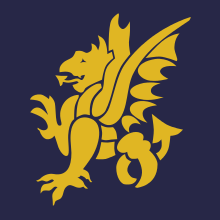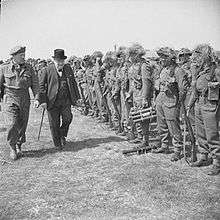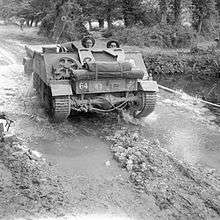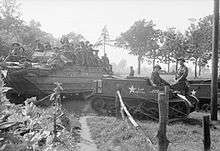43rd (Wessex) Infantry Division
| Wessex Division 43rd (Wessex) Division 43rd (Wessex) Infantry Division | |
|---|---|
 Formation patch of the 43rd Division, World War II. | |
| Active |
1908–1919 1920–1945 1947–1961 |
| Country |
|
| Branch |
|
| Type | Infantry |
| Size | Division |
| Nickname(s) | "The Fighting Wessex Wyverns" |
| Engagements |
World War I World War II |
| Commanders | |
| Notable commanders |
Arthur Percival Sir Ivor Thomas Sir George Erskine |
The 43rd (Wessex) Infantry Division was an infantry division of the British Army. The division served with distinction in the Second World War on the Western Front from June 1944 until May 1945, suffering heavy casualties but gaining an excellent reputation and was known to the Germans as the Yellow Devils.
The division was disbanded and again reformed in the Territorial Army (TA) after the war. Beckett 2008 claims that Territorial Army units that were in suspended animation were formally reactivated on 1 January 1947, though no personnel were assigned until commanding officers and permanent staff had been appointed in March and April 1947.[1] On 1 May 1961 the division was merged with a district to become 43rd (Wessex) Division/District.[2]
Formation
The division was created in 1908, originally as the Wessex Division, as part of the Territorial Force. It had under command the Hampshire Brigade, the South Western Brigade and the Devon and Cornwall Brigade, along with numerous other support units of the Royal Artillery, Royal Engineers and the Royal Army Medical Corps.
World War I
On 24 September 1914, a few weeks after the outbreak of World War I, the division accepted overseas service in British India in order to relieve regular units that were required for active service in Europe. The Divisional and Brigade HQs, both artillery and infantry, did not embark for India. The "Division" sailed on 9 October 1914 and arrived in India in November, where it remained throughout the war, reverting to peacetime service conditions. However, it supplied battalions and drafts of replacements for the divisions fighting in the Middle East, seeing no active service. In May 1915 it became the 43rd (Wessex) Division and the brigades were redesignated the 128th (Hampshire) Brigade, 129th (South Western) Brigade and the 130th (Devon and Cornwall) Brigade respectively.
Order of battle
- 1/4th Battalion, Hampshire Regiment left March 1915 (Mesopotamia)
- 1/5th Battalion, Hampshire Regiment
- 1/6th Battalion, Hampshire Regiment left September 1917 (Mesopotamia)
- 1/7th Battalion, Hampshire Regiment left January 1918 (Aden) but remained under Divisional command
- 1/4th Battalion, Prince Albert's (Somerset Light Infantry) left February 1916 (Mesopotamia)
- 1/5th Battalion, Prince Albert's (Somerset Light Infantry) left May 1917 (Palestine)
- 1/4th Battalion, Dorsetshire Regiment left February 1916 (Mesopotamia)
- 1/4th Battalion, Duke of Edinburgh's (Wiltshire Regiment) left September 1917 (Palestine)
130th (Devon and Cornwall) Brigade
- 1/4th Battalion, Devonshire Regiment left February 1916 (Mesopotamia)
- 1/5th Battalion, Devonshire Regiment left April 1917 (Palestine)
- 1/6th Battalion, Devonshire Regiment left January 1916 (Mesopotamia)
- 1/4th Battalion, Duke of Cornwall's Light Infantry left January 1916 (Aden) then went to Palestine in February 1917
Divisional Artillery
- CCXV (I Wessex) Brigade, Royal Field Artillery (RFA) left October 1916 (Mesopotamia)
- CCXVI (Howitzer) (II Wessex) Brigade, RFA
- CCXVII (III Wessex) Brigade, RFA
- CCXVIII (IV Wessex) Brigade, RFA
- Wessex (Hampshire) Heavy Battery, Royal Garrison Artillery did not go to India
- 1st Wessex Field Company did not go to India (joined 27th Division)
- 2nd Wessex Field Company did not go to India (joined 27th Division)
- Wessex Divisional Signals Company did not go to India (joined 27th Division)
Royal Army Medical Corps
- 1st Wessex Field Ambulance did not go to India (joined 8th Division)
- 2nd Wessex Field Ambulance did not go to India (joined 8th Division)
- 3rd Wessex Field Ambulance did not go to India (joined 8th Division)
Other Divisional Troops
- Wessex Divisional Transport and Supply Column ASC did not go to India (formed 29th Division Train and 27th Divisional Reserve Park)
Second World War
The 43rd Division was reformed a 1st Line Territorial Army formation after the war and was mobilised, as was the rest of the Territorial Army, shortly after the outbreak of the Second World War in September 1939.[3]
In May 1940, the division was preparing to go overseas to join the British Expeditionary Force (BEF) in France and Belgium but the Battle of France and the BEF's retreat to Dunkirk and subsequent evacuation changed all that. The division then spent many years in the United Kingdom on home defence, anticipating the potentiality of a German invasion of the British Isles.[3]

In 1942, however, after the German invasion of the Soviet Union and the entrance of the United States into the war, the situation changed and the 43rd Division started training for offensive operations to return to mainland Europe. Throughout most of 1942, the division was part of XII Corps, serving alongside the 46th Infantry Division and 53rd (Welsh) Infantry Division. XII Corps was, at the time, commanded by Lieutenant-General Bernard Montgomery.[3]
In March 1942, the division also gained a new General Officer Commanding (GOC) in the form of Major-General Ivor Thomas. Thomas was a decorated officer who had served as a young battery commander in the Royal Artillery on the Western Front during World War I where he was twice wounded and awarded the Military Cross and the Distinguished Service Order. He would command the 43rd Division until September 1945.[3]
In August 1942, the 128th Infantry Brigade (consisting of three battalions of the Hampshire Regiment) was transferred to the 46th (West Riding) Infantry Division, remaining with that division for the rest of the war. The 34th Tank Brigade arrived in September 1942 as part of an experiment with 'Mixed Divisions'.[3] However the experiment was abandoned (deemed unsuitable for the type of terrain in North-western Europe) in late 1943 and the 34th Tank Brigade was replaced, in October 1943, by the 214th Infantry Brigade, which was previously a Home Defence formation raised during the war. The 214th Brigade would remain with the 43rd Division for the rest of the war.[3]

In June 1944, the 43rd (Wessex) Division was sent to Normandy, after the Allies invaded France on 6 June, where it joined the British Second Army and was initially earmarked as a reserve for Operation Epsom during the Battle for Caen. In July, it launched an attack, Operation Jupiter, against the German 9th SS Panzer Division on Hill 112, though it was beaten back after both sides had suffered horrendous casualties. The 43rd (Wessex) Division performed well in Normandy and was considered by many senior British officers to be one of the best divisions of the British Army during the Second World War. For the rest of the war Bernard Montgomery, commanding all British and Canadian troops in the campaign, preferred to use formations such as 43rd (Wessex) and 15th (Scottish) to spearhead his assaults. This was mainly due to issues of morale because veteran formations such as the 7th Armoured and 51st (Highland), both of which had seen extensive service in North Africa and the Mediterranean (and fought poorly in Normandy, according to senior officers), were judged as tired and war-weary with morale being almost dangerously fragile. With formations that had spent years in the United Kingdom training such as the 43rd (Wessex), 11th Armoured, 15th (Scottish) and 59th (Staffordshire) Divisions the problem of morale wasn't such an issue.[3]


The 43rd (Wessex) Division was the first British formation to cross the Seine river, with an assault crossing at the French town of Vernon opposed by the 49th German Infantry Division (see 'Assault Crossing, The River Seine 1944' by Ken Ford). This crossing enabled the armour of XXX Corps, under Lieutenant General Brian Horrocks, to thrust across northern France into Belgium.
Still, with XXX Corps, the division later played a major role in Operation Market Garden as the support to the Guards Armoured Division. During Market Garden, the 4th Battalion, Dorset Regiment of the 130th Infantry Brigade, successfully crossed the Rhine as a diversion, so that the battered remnants of the airborne troops of 1st Airborne Division, virtually destroyed as a fighting formation during the Battle of Arnhem, could withdraw more safely; yet the cost was high as many men of the 4th Battalion, Dorsets were themselves left behind on the north bank of the Rhine when the 43rd Division was forced to withdraw.

After Market Garden the division garrisoned "The Island" and later participated in Operation Clipper alongside the U.S. 84th Infantry Division. The division then later played a comparatively small part in the mainly American Battle of the Bulge, the largest battle on the Western Front during World War II, where it was placed on the river Meuse as a reserve. The 43rd later played a large part in Operation Veritable attached to First Canadian Army, again as part of XXX Corps. They then crossed the River Rhine as the Allies invaded Germany itself.[3]
By the end of the war in Europe, the 43rd Division had reached the Cuxhaven peninsula of northern Germany. Throughout the North West Europe Campaign the 43rd (Wessex) Division, like so many other Allied divisions that fought from Normandy to Germany, had suffered very heavy casualties with the majority of them, 80% in some units, being suffered by the average Tommy in the infantry battalions. From June 1944 to May 1945 the 43rd (Wessex) Division, or the Yellow Devils or British SS Division as known by the Germans, had suffered well over 12,500 casualties, with almost 3,000 killed in action.
Order of battle
The 43rd Infantry Division was constituted as follows during the war[4]
128th Infantry Brigade (left 6 June 1942)[5]
- 1/4th Battalion, Hampshire Regiment
- 2/4th Battalion, Hampshire Regiment
- 5th Battalion, Hampshire Regiment
- 128th Infantry Brigade Anti-Tank Company (formed 19 June 1940, disbanded 20 December 1941)
- 4th Battalion, Somerset Light Infantry
- 4th Battalion, Wiltshire Regiment
- 5th Battalion, Wiltshire Regiment
- 129th Infantry Brigade Anti-Tank Company (formed 14 May 1940, disbanded 20 December 1941)
- 7th Battalion, Hampshire Regiment
- 4th Battalion, Dorsetshire Regiment
- 5th Battalion, Dorsetshire Regiment
- 130th Infantry Brigade Anti-Tank Company (formed 17 May 1940, disbanded 20 December 1941)
25th Tank Brigade (from 1 June 1942, left 2 September 1942)[8]
- 51st (Leeds Rifles) Royal Tank Regiment
- 11th Royal Tank Regiment
- 142nd Regiment Royal Armoured Corps
34th Tank Brigade (from 3 September 1942, left 10 September 1943)[9]
- North Irish Horse (left 3 September 1942)
- 147th Regiment Royal Armoured Corps
- 153rd Regiment Royal Armoured Corps
- 151st Regiment Royal Armoured Corps (from 3 September 1942)
214th Infantry Brigade (from 5 September 1943)[10]
- 7th Battalion, Somerset Light Infantry
- 5th Battalion, Duke of Cornwall's Light Infantry
- 9th Battalion, Somerset Light Infantry (left 30 September 1943)
- 1st Battalion, Worcestershire Regiment (from 30 September 1943)
Divisional Troops
- 1/8th Battalion, Middlesex Regiment (joined as Machine Gun Battalion from 18 November 1941, redesignated 8th Battalion May 1942, left 1 October 1942, rejoined as Support Battalion 1 October 1943, again as MG Battalion 28 February 1944)
- 48th Battalion, Reconnaissance Corps (from 20 November 1941, redesignated 43rd Battalion 1 January 1942, later 43rd Regiment 6 June 1942, finally 43rd (Wessex) Reconnaissance Regiment, Royal Armoured Corps 1 January 1944)
- 94th (Queen's Own Dorset Yeomanry) Field Regiment, Royal Artillery
- 112th (Wessex) Field Regiment, Royal Artillery
- 141st (Queen's Own Dorset Yeomanry) Field Regiment, Royal Artillery (left 8 June 1942)
- 179th Field Regiment, Royal Artillery (from 9 June 1942)
- 59th (Duke of Connaught's Own) Anti-Tank Regiment, Royal Artillery
- 110th (Dorset) Light Anti-Aircraft Regiment, Royal Artillery (from 23 March 1942)
- 43rd (Wessex) Divisional Engineers
- 204th (Wessex) Field Company, Royal Engineers
- 260th Field Company, Royal Engineers
- 553rd Field Company, Royal Engineers (from 13 January 1940)
- 207th (Wessex) Field Park Company, Royal Engineers
- 13th Bridging Platoon, Royal Engineers (from 1 October 1943)
- 43rd (Wessex) Divisional Signals Regiment, Royal Corps of Signals
After the war
The division was reactivated after the Second World War again as part of the Territorial Army. On 1 April 1967 the Royal Monmouthshire Royal Engineers absorbed 43rd Wessex Division RE (TA).[11] All TA divisions were disbanded by 1968.
Commanders
- Brigadier-General William J. Kirkpatrick: April–December 1908
- Major-General Charles J. Blomfield: January 1909-February 1911
- Major-General Colin G. Donald: February 1911-November 1914
- Major-General Sir C.P. Amyatt Hull: June 1919-September 1920
- Major-General Sir Louis J. Bols: September 1920-September 1924
- Major-General Sir Edward Northey: September 1924-October 1926
- Major-General Sir George D. Jeffreys: October 1926-October 1930
- Lieutenant-General Reginald J.T. Hildyard: October 1930-October 1934
- Major-General Baptist B. Crozier: October 1934-December 1938
- Major-General Arthur Floyer-Acland: December 1938-February 1940
- Major-General Arthur Percival: February–April 1940
- Major-General Robert Pollok: April 1940-February 1941
- Major-General Charles Allfrey: February 1941-March 1942
- Major-General Gwilym Ivor Thomas: March 1942-September 1945
- Major-General George W.E.J. Erskine: September-? 1945
- Major-General John B. Churcher: -March 1946
- Major-General George W. Symes: March 1946-December 1948
See also
- List of British divisions in World War I
- List of British divisions in World War II
- British Army Order of Battle (September 1939)
- The memorial to the unit at Castle Hill
- Rough Tor, in Cornwall, was given to the nation as a memorial to the men of the Division who gave their lives in the North-West European Campaign.
References
- ↑ Beckett 2008, 169.
- ↑ Beckett 2008, 183, 185, and regiments.org (archive), South Western District 1905-1972, accessed September 2012.
- 1 2 3 4 5 6 7 8 "badge, formation, 43rd (Wessex) Infantry Division". Imperial War Museum. Retrieved 4 August 2017.
- ↑ Joslen, pps. 69-70.
- ↑ Joslen, p. 313.
- ↑ Joslen, p. 314.
- ↑ Joslen, p. 315.
- ↑ Joslen, p. 203.
- ↑ Joslen, p. 207.
- ↑ Joslen, p. 377.
- ↑ "Corps of Royal Engineers, Volunteer Regiments". Archived from the original on 22 September 2007. Retrieved 16 September 2016.
Bibliography
- Ian F.W. Beckett, 'Territorials: A Century of Service,' First Published April 2008 by DRA Printing of 14 Mary Seacole Road, The Millfields, Plymouth PL1 3JY on behalf of TA 100, ISBN 978-0-9557813-1-5, 175, 180.
- Joslen, Lt-Col H.F. (2003) [1st pub. HMSO:1960]. Orders of Battle: Second World War, 1939–1945. Uckfield: Naval and Military Press. ISBN 978-1-84342-474-1.